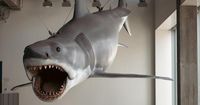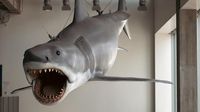It’s been half a century since a monstrous shark first lurked beneath the waves of Amity Island, sending chills down the spines of moviegoers everywhere. In 2025, the Academy Museum of Motion Pictures in Los Angeles is commemorating the 50th anniversary of Steven Spielberg’s iconic thriller, Jaws, with a sprawling new exhibition that offers fans and film buffs an unprecedented look behind the scenes of the blockbuster that changed Hollywood forever.
The exhibition, aptly titled "Jaws: The Exhibition," is the largest display ever dedicated to a single film at the Academy Museum. According to NPR, it features more than 200 artifacts spread across several galleries, ranging from original props and costume pieces to rare production notes and stills. At the heart of the experience is a meticulous recreation of the doomed fishing boat, the Orca, complete with the famous leather booth where actors Richard Dreyfuss and Robert Shaw compared scars in one of the film’s most memorable scenes.
Visitors are invited to step into the world Spielberg and his crew painstakingly constructed on Martha’s Vineyard five decades ago. As described by the Associated Press, the exhibition brings together items from collectors, the director’s personal archive, and even the original set. Curator Jenny He told reporters, “It really was a cinematic treasure hunt,” explaining how the museum team tracked down objects that would help visitors piece together the story of Jaws in a tangible, physical way.
Steven Spielberg, now widely regarded as one of the most influential filmmakers of all time, was just 27 when he completed directing Jaws and 28 when it hit theaters. The film’s production, however, was anything but smooth sailing. Speaking to NPR’s Cory Turner, Spielberg recalled the stress and uncertainty that plagued the shoot. “This is therapy. This is total therapy,” he said, reflecting on the exhibit. “This was a very hard experience when we seriously did not know how many weeks or months we were going to be in Martha’s Vineyard shooting.”
Spielberg recounted how the film’s ballooning budget and schedule nearly ended his career before it had truly begun. “I thought my career was virtually over halfway through production on Jaws, because everybody was saying to me: ‘You are never going to get hired again. This film is way over budget and way over schedule, and you are a real liability as a director.’” But history, as he wryly noted, had different ideas.
Indeed, Jaws went on to win three Oscars, spawn three sequels, and set a benchmark for the modern thriller. The film starred Roy Scheider, Richard Dreyfuss, and Robert Shaw, whose legendary monologue about the sinking of the USS Indianapolis remains one of cinema’s most chilling moments. Spielberg revealed that this scene had to be shot twice after Shaw, having asked for a drink before filming, was unable to perform the first time. “Robert said, well, I want to do it tomorrow morning, first thing. Can we just hit the ground running first thing in the morning? — which we did. And he knocked it out of the ballpark,” Spielberg recalled to NPR.
But the stress of the production left its mark on the young director. “Waking up with all the sheets wet because I would sweat through all my clothes at night sleeping, my — you know, I had serious PTSD for years,” Spielberg admitted. Yet, he found solace in the Orca itself. After the film’s success, Universal Studios brought the original prop boat to its back lot in Los Angeles for tourists. Spielberg would sneak onto the boat, sit in the little cabin, and process the emotional roller coaster of making Jaws. “Having an emotional reaction to my memories, and when I felt good about it, a good cry or a good laugh, I would just get back in my golf cart, go back to my office,” he told NPR.
Sadly, the original Orca was eventually destroyed after an inspector discovered it was riddled with termites. The three mechanical sharks used during filming — affectionately nicknamed Bruce after Spielberg’s lawyer — met a similarly undignified end, left to rot and ultimately discarded. Only one final shark, made from the original mold, survived for a time, hanging at Universal Studios until 1990 before it too was thrown out.
But the story doesn’t end there. In an earlier NPR investigation, Cory Turner tracked down the last remaining Bruce in a California junkyard. The owner eventually donated the shark to the Academy Museum, where it underwent a terrifying restoration. Now, this very Bruce hangs proudly at the end of the exhibition, a testament to the film’s enduring legacy and the lengths fans and collectors will go to preserve a piece of movie history.
Visitors to the exhibition aren’t just passive observers. According to the AFP, they can try their hand at reproducing the film’s menacing “da-dum-da-dum” theme — the Oscar-winning score by John Williams that’s become shorthand for imminent danger. There’s also a replica of the shark for guests to handle, as well as behind-the-scenes footage that peels back the curtain on the groundbreaking special effects and the many mishaps that befell the crew.
Spielberg, reflecting on the exhibition and the collectors who preserved so many artifacts, expressed his gratitude. “The film certainly cost me a pound of flesh, but gave me a ton of career,” he told reporters. “When we shot the opening scene of Chrissie Watkins being taken by the shark and we had a buoy floating in the water, how did anybody know to take the buoy and take it home and sit on it for 50 years?”
For Spielberg, the battered shark prop that now greets visitors at the Academy Museum is more than just a relic. “Thank you for a robust career. Without you, you know, I don’t know what — I would have — certainly, my next three or four movies wouldn’t have been those same movies because Jaws gave me the chance to make anything I wanted to make. It kicked my a** for nine months, but it gave me a lifetime career,” he said to NPR.
Open to the public as of mid-September 2025, “Jaws: The Exhibition” will run through the next beach season, offering fans old and new a chance to relive the terror, the triumph, and the sheer cinematic magic of a film that changed the course of Hollywood history. For those brave enough to face Bruce up close, the Academy Museum in Los Angeles is the place to be this year.





